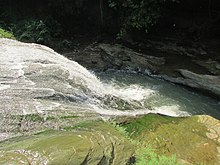Badis pallidus
| Badis pallidus | ||||||||||||
|---|---|---|---|---|---|---|---|---|---|---|---|---|
| Systematics | ||||||||||||
|
||||||||||||
| Scientific name | ||||||||||||
| Badis pallidus | ||||||||||||
| Kullander , Norén , Rahman & Mollah , 2019 |
Badis pallidus is a blue bass of the genus Badis . It was only described in 2019and lives in mountain streams in the catchment area of the Karnaphuli in the Chittagong division , in the southeast of Bangladesh .
description
The body of Badis pallidus is elongated with a standard length of 25 to 39 millimeters and strongly flattened on the sides. The head takes up about three tenths of the standard length. There is great variability in drawing and body structure. The eyes of both sexes stand far forward and are roughly in line with the longitudinal axis of the body or a little lower. The lower jaw protrudes only slightly. Nothing is known about the live color. The types have a pale beige base color with a conspicuous dark brown spot on the shoulder and ten black or dark brown horizontal stripes on the sides up to the tail fin stalk.
In the middle longitudinal row there are 26 to 28 scales, in the side line 17 to 23 and around the caudal stalk 15 to 17 scales. The dorsal and anal fins are long with rounded tips. They reach in length to about a quarter or a third of the caudal fin, while the fins of larger specimens are relatively longer. The caudal fin is rounded. The pectoral fins are rounded, they reach about two thirds of the way from their base to the anal fin. The pelvic fins are elongated but not pointed. Their ends only reach the anus in large males, but they usually stay shorter.
- Fin formula
Dorsal XVI – XVII / 8½ – 9, anals 6½ – 8½, pectorals 11–13.
Badis pallidus can hardly be distinguished from Badis chittagongis morphologically . The individuals have an overall lighter body color with only 15 to 17 instead of 16 to 20 scales around the caudal fin stalk and other only minor deviations in the drawing and scale formula. Badis pallidus also resembles the bluefish ( Badis badis ) Badis ferrarisi , Badis kanabos , Badis Khwae , Badis ruber , Badis siamensis , Badis soraya and Badis tuivaiei with which it has its dark humeral spot together. The species differs from Badis khwae , Badis ruber and Badis siamensis by the lack of a dark spot in the upper area of the caudal fin stalk . Compared to Badis ferrarisi , the short black horizontal stripes on the flanks and the dark spot on the gill covers are missing. Compared to the blue perch, Badis pallidus has a flatter build, a larger eye relief relative to the standard length, more scales in the central longitudinal row and 13 instead of 12 pectoral fin rays. Compared to Badis kanabos , it has a shorter eye relief relative to the standard length, a larger number of scales in the middle longitudinal row and 13 instead of 12 pectoral fin rays. From Badis ferrisi differs Badis pallidus by the absence of distal extrascapularen bones.
distribution
Badis pallidus has so far only been detected in mountain streams in the northern Chittagong Hill Tracts , which belong to the catchment area of the Karnaphuli . There are numerous localities for the species in this area. The type location is below the rapids waterfall Shailopropat ( 22 ° 9 '6 " N , 92 ° 12' 59" O ) in the Upazila Thanchi, district Bandarban . There the water runs over a wide limestone cliff with a maximum drop of ten meters, followed by rapids in a bed of gravel and numerous rocks. The river belongs to the catchment area of the Sangu , which is a tributary of the Karnaphuli. More detailed descriptions of the other sites are not available.
Systematics and taxonomy
Badis pallidus is one of around 25 species of the Badis Bleeker genus , dating from 1854, almost all of which were not described until the 21st century. The first descriptions of ten of these species, including the closely related Badis chittagongis , were published in 2002 by Sven O. Kullander and his colleague Ralf Britz as part of a revision of the Badis genus . Based on molecular genetic investigations, Badis chittagongis was recognized as paraphyletic and the morphologically indistinguishable species Badis pallidus was described. It belongs to the Badis badis group together with the blue bass , Badis chittagongis , Badis ferrarisi and Badis kanabos .
The holotype is an adult male captured in May 2015. It is located with numerous paratypes from the type and other localities in the Chittagong division in the collection of the University of Dhaka . Other paratypes are kept in the Naturhistoriska riksmuseet in Stockholm . The species name pallidus comes from the Latin language and means pale , it refers to the pale gray body color of male specimens.
Individual evidence
- ↑ a b c d e f Sven O. Kullander et al .: Chameleonfishes in Bangladesh: hipshot taxonomy, sibling species, elusive species, and limits of species delimitation (Teleostei: Badidae) . In: Zootaxa 2019, Volume 4586, No. 2, doi : 10.11646 / zootaxa.4586.2.7 (first description).
- ↑ a b Sven O. Kullander and Ralf Britz : Revision of the family Badidae (Teleostei: Perciformes), with a description of a new genus and ten new species . In: Ichthyological Exploration of Freshwaters 2002, Volume 13, No. 4, pp. 295-372, here pp. 314-316, ISSN 0936-9902 .
- ^ Sven O. Kullander and Ralf Britz: Revision of the family Badidae , pp. 370–371.
